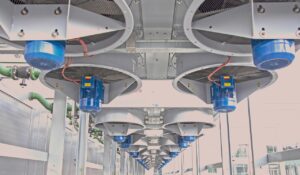AI Data Centers Near Tax Break With $165 Billion of Phantom Debt
Summary / Hook:
A recent industry analysis reveals a startling mismatch between the surge in AI data-center construction and the underlying economics of those facilities: roughly $165 billion of what analysts are calling “phantom debt” — accounting and tax attributes and depreciation claims that overstate real economic value — are on the books just as jurisdictions consider generous tax breaks to attract AI campuses. If policymakers, investors and local communities don’t pause to reconcile incentives with transparent, hard financials, the rush to win AI infrastructure projects risks leaving taxpayers with little long-term benefit and investors holding assets that don’t produce the cash flows they expect. Bloomberg.commint
Why this matters (quick take)
-
Governments are offering tax breaks and other incentives to lure AI data centers because they promise jobs, large capital investment and technological prestige. mint
-
But many of these projects carry accounting structures and depreciation schedules that create paper losses and ‘phantom’ debt — numbers that look large on balance sheets yet may not represent sustainable cash liabilities or real economic value. Bloomberg.com
-
The discrepancy — estimated at $165 billion in phantom debt — means incentives could be mispriced, budgets misallocated, and local governments exposed to fiscal risk if projected property-tax receipts or job creation fail to materialize. Bloomberg.com
The claim in context: what the $165 billion number represents
The phrase “$165 billion of phantom debt” comes from recent reporting and analysis that aggregates accounting attributes attached to the wave of planned AI data-center expansions. This figure does not necessarily mean there are $165 billion of legally enforceable loans waiting to be collected; rather, it captures a mix of accelerated depreciation, leasing obligations, tax equity structures, and other financial engineering that inflate reported liabilities or future tax benefits on paper. Policymakers often assess project viability based on headline investment figures and employment estimates, not nuanced accounting treatments — making this gap dangerous. Bloomberg.commint
How AI data centers create “phantom” numbers
Data centers built for AI workloads differ from traditional colocation facilities in several ways that drive unusual accounting effects:
-
Capital intensity & specialized hardware: AI facilities rely on GPUs, high-density power delivery and liquid cooling. These assets have high upfront costs and very different depreciation and obsolescence profiles than standard servers. Companies and lessors may use accelerated depreciation or bespoke lease terms that produce large paper losses or tax shields early on. Bloomberg.com
-
Long-term leases and tax equity: Many projects are structured using long leases, third-party investors, and tax-equity partners. Those structures can push liabilities onto local balance sheets in opaque ways while promising future tax benefits that may never be realized if hardware becomes obsolete. Bloomberg.com
-
Rapid obsolescence and underutilization risk: AI accelerators improve quickly: an H100 today may be superseded in a couple of years. This can leave giant data halls filled with expensive equipment that no longer commands the same return on investment, but still carries depreciation schedules and lease obligations. Bloomberg.com
These mechanics combine to create the phantom debt phenomenon: headline numbers that look like massive obligations or investments but that don’t track with sustainable revenue streams.
Tax breaks: why local governments still say “yes”
Local and state governments usually offer incentives because they expect:
-
Job creation — both construction and operations roles (though many AI data-center jobs are highly specialized and relatively small in number compared with the capital outlay). mint
-
Property and sales tax revenue — from construction activity and equipment purchases.
-
Economic multipliers — nearby suppliers, improved broadband and prestige that can attract additional investment.
However, when towns base decisions on gross investment figures (size of campus, sq. ft., total capital spend) without stress-testing the operating model or understanding depreciation and leasing structures, they risk overpaying for ephemeral benefits. The $165 billion figure raises the question: are jurisdictions awarding breaks to projects whose real economic benefits are far smaller than the promotional materials imply? Bloomberg.commint
Who wins — and who loses — under current incentives
Winners:
-
Cloud and AI infrastructure providers may capture immediate construction revenue and secure long-term capacity for their clients.
-
Equipment manufacturers sell large volumes of GPUs, power distribution units and cooling gear.
-
Real estate developers benefit from construction fees and land appreciation.
Potential losers:
-
Local taxpayers if promised jobs and tax revenues underperform projections.
-
Late investors who buy equity or debt instruments priced on optimistic utilization forecasts.
-
Smaller firms and communities who may divert public funds to subsidies rather than schools, roads or more diversified economic development.
Several jurisdictions have already committed generous packages to data-center projects; the new reporting suggests that the fiscal math behind some of these deals has not been fully reconciled with the specific accounting and depreciation dynamics of AI hardware. mint
Real-world example: big projects, tricky economics
Recent coverage has highlighted specific projects and counties negotiating with AI data-center developers — for example, a multi-site initiative proposed near Las Cruces in Dona Ana County. Local officials face pressure to deliver incentives to secure the campus, but analysts warn the project’s reported numbers may mask complex financing arrangements and depreciation schedules that produce large paper liabilities while actual cash flows remain uncertain. (Reporting on the broader issue and the $165 billion aggregation was published recently in major outlets.) Bloomberg.com+1
The accounting mechanics: an accessible explainer
Here’s a simplified walkthrough of the main accounting levers that create phantom debt:
-
Accelerated depreciation: Owners/lessors claim higher depreciation expenses early — which reduces taxable income now but produces smaller deductions later. This creates a present-day tax advantage that may overstate long-term economic benefit. Bloomberg.com
-
Operating vs. capital leases: Structuring a deal as a capital lease can place the asset and its associated liability on a balance sheet, even if cash flows are restricted or conditional.
-
Tax equity and third-party financing: Investors buy tax benefits rather than operational returns; when tax credits or deductions are the main attraction, underlying operational viability can be secondary. Bloomberg.com
-
Intangible value claims: Some proposals include projected ‘AI cluster’ benefits or future-state spillovers that are speculative and often counted in pro-project analyses without robust sensitivity testing.
When municipalities accept headline CAPEX figures without requiring independent verification of these mechanics, they may be enticed by numbers that don’t reflect the net present value of real economic activity.
Policy implications — what governments should demand before granting breaks
Policymakers can adopt several practical steps to reduce risk and ensure incentives deliver measurable public value:
-
Require independent financial audits and sensitivity analyses that isolate tax engineering from real economic benefits. Don’t rely solely on developer-provided projections.
-
Structure incentives with clawbacks and performance milestones (jobs, uptime, local procurement thresholds) rather than one-time grants tied to headline capital spend.
-
Focus on net present value (NPV) of projected tax receipts adjusted for depreciation schedules, rather than gross investment figures.
-
Mandate transparency on lease and financing terms, so local treasuries understand contingent liabilities and the true distribution of tax benefits.
-
Encourage workforce development conditions to ensure more local hires for operations and maintenance roles (not just temporary construction jobs).
-
Consider alternative incentives (reduced property tax for a limited time, infrastructure grants tied to community projects, or investment in local grid resilience) that yield durable public goods.
These measures align incentives with measurable outcomes and reduce the chance that phantom accounting swells headline numbers used to justify large public subsidies. Bloomberg.com
Investor perspective: how to value AI data-center deals
Investors and lenders should treat AI data-center assets differently from traditional real estate:
-
Stress test utilization assumptions: AI workloads are bursty and can pivot quickly as model architectures shift.
-
Value equipment depreciation realistically: GPUs and accelerators age rapidly; plan for hardware refreshes and stranded-asset risk. Bloomberg.com
-
Require transparency on leaseback and take-or-pay arrangements: long-term contracts with credible counterparties reduce risk; short or uncertain commitments increase it.
-
Analyze local grid and water resiliency: AI facilities consume large amounts of power and sometimes water; interruptions can materially affect operations. (Regulatory or environmental constraints can change economics fast.)
If the $165 billion figure reflects legitimate balance-sheet exposures across many deals, investors will need to price in a higher risk premium and require stronger covenants. Bloomberg.com+1
Community and environmental lens
Beyond finances, communities should weigh environmental and infrastructure impacts:
-
Energy demand and grid strain: AI data centers draw significant power; without proper grid upgrades and clean-energy commitments, the net environmental benefit of hosting a data center can be negative. Bloomberg.com
-
Water usage: Some cooling approaches consume water; arid regions face tradeoffs between economic development and resource stress.
-
Local ecosystem and land use: Large campuses change land values and can displace other industries or limit future land uses.
Public officials must factor these externalities into incentive decisions — not just the headline job or capital numbers that projects advertise. Bloomberg.com
What responsible reporting and public debate should look like
Good journalism and public oversight can reduce fuzzy accounting:
-
Expose the financing structures behind projects — who owns equipment, who benefits from tax deductions, and who bears long-term risk. Bloomberg.com
-
Compare similar deals across states to see which incentive models generate durable local value vs. short-term headlines. mint
-
Ask independent economists to model best- and worst-case scenarios, and publish those in accessible formats for community review.
When reporting aggregates figures such as $165 billion of phantom debt, journalists should clearly explain what is phantom (accounting artifacts) and what is real (contractual obligations), so citizens can judge the tradeoffs their governments are making. Bloomberg.commint
Bottom line — move slowly, require clarity
AI data centers are essential infrastructure for the modern economy, and attracting them can be a legitimate strategic priority. Still, the $165 billion phantom-debt finding is a wake-up call: the rush to offer tax breaks and incentives must be matched by rigorous financial scrutiny, transparent deal terms, and performance-based incentives that protect taxpayers and investors alike. Otherwise, communities may end up subsidizing paper gains while real economic upside proves limited.
Quick checklist for local officials (one page)
-
Demand independent financial audits.
-
Use clawbacks and milestone-based incentives.
-
Require public disclosure of lease, financing and depreciation terms.
-
Stress-test revenue and utilization assumptions.
-
Tie incentives to workforce development and local procurement.
-
Evaluate environmental and grid impacts before approving tax packages.
Closing thought
AI infrastructure will reshape regions and industries, but the tools we use to measure its value — spreadsheets, proforma projections, and headline CAPEX figures — must be calibrated for a world of fast-changing hardware, creative financing and significant public interest. The $165 billion figure should not be read as a reason to halt AI projects; it should be read as an alarm to design better, fairer, and more transparent deals.
Sources (selected reporting and industry analysis)
-
Bloomberg: AI Data Centers Near Tax Break With $165 Billion of Phantom Debt. Bloomberg.com+1
-
LiveMint coverage of the Bloomberg report and local project contexts. mint
-
Bloomberg coverage and interviews with data-center leaders on capital intensity, power and hardware refresh cycles. Bloomberg.com
https://bitsofall.com/human-ai-collaboration-robotics-future-of-work/
https://bitsofall.com/trump-claims-india-offered-reduce-tariffs-to-zero-its-getting-late/
Robotics Learning: Shaping the Future of Education and Innovation








